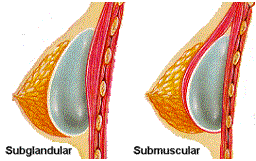Breast Implants
View Breast Implant Before and After Photos
What does breast augmentation do?
Are saline implants approved by the FDA?
Are silicone implants approved by the FDA?
What are all my options in breast implants?
How much does breast augmentation cost?
What does breast augmentation do?
Breast augmentation will enlarge your breasts. It will not improve nipple asymmetry, move breasts closer together, or lift droopy breasts. If you have droopy breasts, consider combining your breast augmentation with a breast lift (mastopexy). Breast augmentation is performed to balance a difference in breast size, improve body contour or as a post-surgery reconstructive technique. Silicone shells filled with saline solution are implanted either directly under the breast tissue or beneath the chest wall muscle, giving breasts a fuller contour.
Are saline implants approved by the FDA?
Yes. On May 10, 2000, the FDA granted approval of saline-filled breast implants manufactured by Mentor Corporation and Allergan (formerly McGhan Medical). To date, all other manufacturers’ saline-filled breast implants are considered investigational.These have a silicone rubber shell and are filled with sterile salt water.
Are silicone implants approved by the FDA?
Yes. On November 17, 2023 the FDA approved silicone gel implants for breast augmentation in women age 22 or older and for breast reconstruction in women of any age. Silicone gel-filled breast implants have a silicone shell that are filled with silicone gel.
What are all my options in breast implants?
You have many different options when it comes to breast implants. During pre-operative exams you and your surgeon will determine:
- Implant shape: round or teardrop
- Implant surface: smooth or textured
- Implant size and volume: cup size/210 ml-500 ml
- Implant placement: above or below the muscle
- Incision site: armpit, areola, breast or belly button
Implant shape
Round implants are not affected by rotation and cost less than teardrop implants. They do not require a textured surface. There are no disadvantages to round implants. This is the most common implant employed.
Teardrop implants were developed to provide a more natural look. They cost more than round implants and require a textured surface to prevent rotation. In the event that the implants rotate, it creates a distorted breast shape.
A recent study determined that a round implant takes on the same shape as the teardrop implant when standing. The study also concluded that when lying down, the round implant is more natural in appearance than the teardrop implant because it retains the teardrop shape and the round implant does not.
Implant surface
Textured implants have an increased risk of rippling but a decreased risk of displacement. They also cost more (about $100). A recent study showed that textured implants have a higher deflation rate and are firmer than smooth implants.
Smooth implants have a lower risk of rippling, are less firm than textured implants. Any rotation of the implant will not affect the appearance. Smooth implants are used in 90% of operations.
Implant size and volume
Implants that are less than 350 ml have a lower risk of displacement, but may not provide the desired size.
Implants that are more than 400 ml have a higher risk of displacement, but may provide the desired size.
Choosing your desired size can be a difficult decision. You’ll want to decide your cup size and that will determine how large your implant will be. A 400 ml implant placed on a woman with an A cup will produce a C cup. The same implant placed on a woman with a B cup will produce a D cup. Bring pictures of your desired size (take a look at a lingerie catalog or swimsuit pictures) to your consultation. Take the time to decide what you’ll be happy with so you don’t feel the need to undergo a second surgery. You can also ask your surgeon for implant sizers to try on different implant sizes.
Be sure your surgeon plans to overfill the implants. This technique decreases the risk of deflation, rippling, and sloshing. There are no disadvantages to overfilling. Implants are meant to be overfilled, and the implant manufacturers recommend surgeons to overfill them.
Implant placement
Implant position refers to whether the breast implant is placed above or below the pectoralis muscle. See Illustration below:
Subpectoral or submuscular implants: Placement under the pectoralis muscle is the approach most commonly used. It has a lower risk of capsular contracture, interferes less with a mammogram, and a better cosmetic result in women with small breasts and a worse cosmetic result in athletic women. It is associated with a lengthier recovery and more pain and swelling than placement above the muscle. This approach requires general anesthetic.
Subglandular implants: Implants that are placed above the pectoralis muscle and below the breast tissue. This has a greater risk of capsular contraction, interferes more with a mammogram, and a worse cosmetic result in women with small breasts. It has a better cosmetic result in athletic women (body builders may want to consider a male pectoral implant as it can look more natural). It is associated with a shorter recovery and less pain and swelling than placement below the muscle. This approach can be performed with intravenous sedation and local anesthetic.
Incision site
Inframammary incision: The incision is made on the lower portion of the breast, in the crease where the breast meets the chest, so that any scar will still be hidden. This incision allows your surgeon the best visibility during surgery. This incision is most commonly done.
Periareolar incision: The second most common incision is made in the areola. The incision is usually a small semi-circle. The scar is camouflaged by the nipple. However, if there are any imperfections in the scar, it will be highly visible. This type of incision has an increased risk for diminished nipple sensation.
Axillary incision: The incision is made in the armpit, and may require the use of an endoscope. The scar is well-hidden, but provides poor visibility for the surgeon.
Umbilical incision: The incision is made in the belly button. It usually requires the use of an endoscope, and it is very difficult to place the implants below the muscle utilizing this method.
How much does breast augmentation cost?
The average surgeon fee for Breast Implants is $3,351. This does not include fees for anesthesia, the surgical facility, or the implants. The cost ranges from $5,000-$10,000 with an average total cost of $7,100.
Related Links: Costs of Plastic Surgery | Breast Implant Before and After Galleries | Breast Lift Information | Breast Lift Before and After Galleries | Find a Plastic Surgeon | Plastic Surgery Guide

